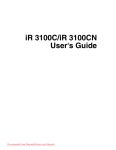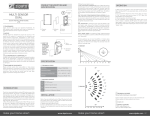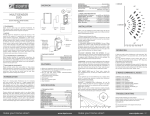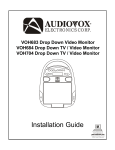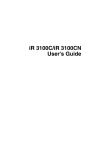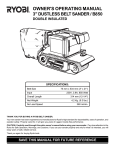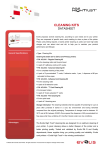Download Craftsman 25335 Owner`s manual
Transcript
620263-963
SEARS
OWNERS
MANUAL
MODEL NO.
31 5.11690
CAUTION'
Read Rules for
®
Safe Operation
and Instructions
Carefully
SANDER
DUAL MOTION
DOUBLE INSULATED
SAVE THIS
MANUAL
FUTURE
FOR
REFERENCE
Introduction
Operation
Repair Parts
.'€
% '
<;.{UL)I!;
',_
Designed
SEARS, ROEBUCK
620263,963
exclusively
for and sold only by
AND CO., Dept. 698/731A,
Sears Tower,
Chicago,
IL 60684
PRINTED
IN U. S A.
FULL ONE YEAR WARRANTY
ON CRAFTSMAN
SANDER
If this Craftsman Sander fails to give complete satisfaction
within one year from date of
RETURN IT TO THE NEAREST SEARS STORE THROUGHOUT
THE UNITED STATES and
replace it, free of charge.
If this sander is used for commercial
or rental purposes this warranty applies for only 90
the date of purchase.
This warranty gives you specific legal rights, and you may also have other rights which
state to state.
SEARS, ROEBUCK AND CO.
DEPT. 698/731A
SEARS TOWER
CHICAGO, IL 60684
purchase,
Sears will
days from
vary from
INTROD UCTION
DOUBLE INSULATION is a concept in safety, in electric power tools, which eliminates the need for the
usual three wire grounded power cord and grounded
supply system. Wherever there is electric current in
the tool there are two complete sets of insulation to
protect the user. All exposed metal parts are isolated
from the internal metal motor components with protecting insulation.
Your sander is suitable for coarse, medium and fine
sanding of wood, metals, and plastics. It will produce a fine scratch free finish when used with or
against the grain and is designed for sanding flush
to corners.
IMPORTANT
-- Servicing of a tool with double insulation requires extreme care and knowledge of the
system and should be performed only by a qualified
service
technician.
For service we suggest
you
return the tool to your nearest Sears Store for repair.
Always use original factory replacement
parts when
servicing.
The dual motion feature with which your sander is
equipped is ideal for any sanding operation where a
pad sander is required. Orbital motion is ideal for
fast cutting
action
when removing
old finishes,
smoothing
rough wood, cutting stock down to required dimensions
or for finishing
surface to be
painted. Straight line is best for fine finish sanding
on work to be stained or varnished.
RULES FOR SAFE OPERATION
WARNING _ DO NOT ATTEMPT TO OPERATE UNTIL YOU HAVE READ THOROUGHLY
AND UNDERSTAND
COMPLETELY ALL INSTRUCTIONS,
RULES, ETC. CONTAINED IN THIS MANUAL. FAILURE TO COMPLY CAN
RESULT IN ACCIDENTS
INVOLVING
FIRE, ELECTRIC SHOCK, OR SERIOUS PERSONAL INJURY. SAVE
OWNERS MANUAL AND REVIEW FREQUENTLY FOR CONTINUING
SAFE OPERATION, AND INSTRUCTING
POSSIBLE THIRD-PARTY USER.
READ ALL INSTRUCTIONS
1. KNOW YOUR POWER TOOL -- Read owner's manual carefully. Learn its applications and limitations as well as the specific potential hazards peculiar to
this tool.
2. GUARD
AGAINST
WITH.GROUNDED
ELECTRICAL
SURFACES.
SHOCK
BY PREVENTING
BODY CONTACT
For example:
Pipes, radiators,
ranges, refrig-
erator enclosures.
3. KEEP GUARDS
IN PLACE and in working
order.
4. KEEP WORK AREA CLEAN. Cluttered
areas and benches
invite accidents.
5. AVOID DANGEROUS
ENVIRONMENT.
Don't use power tool in damp or wet
locations
or expose to rain. Keep work area well lit.
6. KEEP CHILDREN
AWAY. All visitors
should
be kept safe distance
from work
area. Do not let visitors
contact
tool or extension
cord.
7. STORE IDLE TOOLS. When not in use, tools should
be stored
in dry, high or
locked-up
place -- out of reach of children.
8. DON'T FORCE TOOL. It will do the job better and safer at the rate for which it
was designed.
9. USE RIGHT TOOL. Don't force small tool or attachment
to do the job of a heavy
duty tool. Don't use tool for purpose
not intended
- for example
- Don't use
a circular
saw for cutting
tree limbs or logs.
10. WEAR PROPER APPAREL.
No loose clothing
or jewelry to get caught in moving
parts. Rubber gloves and footwear
are recommended
when working
outdoors.
Also, wear protective
hair covering
to contain
long hair.
Pane "_
RULES FOR SAFE OPERATION
(Continued)
11. USE SAFETY
GLASSES
with all tools. Also
face or dust
mask
if cutting
operation
is dusty.
12. DON'T ABUSE CORD. Never carry tool by cord or yank it to disconnect
from
receptacle.
Keep cord from heat, oil and sharp edges.
13. SECURE WORK. Use clamps
or a vise to hold work. It's safer than using your
hand and it frees both hands to operate
tool.
14. DON'T OVERREACH.
Keep proper footing
and balance at all times.
15. MAINTAIN
TOOLS WITH CARE. Keep tools sharp at all times, and clean for best
and safest performance.
Follow
instructions
for lubricating
and changing
accessories.
16. DISCONNECT
TOOLS. When not in use, before servicing,
or when changing
attachments,
blades, bits, cutters,
etc., all tools should be disconnected.
17. REMOVE ADJUSTING
KEYS AND WRENCHES.
Form habit of checking
to see
that keys and adjusting
wrenches
are removed
from tool before turning
it on.
18. AVOID ACCIDENTAL
STARTING.
Don't carry plugged-in
tools with finger on
switch.
Be sure switch
is off when plugging
in.
19. OUTDOOR
USE EXTENSION
CORDS.
When tool is used outdoors,
use only
extension
cords suitable
for use outdoors.
Outdoor
approved
cords are marked
with the suffix W-A, for example
-- SJTW-A or SJOW-A.
20. NEVER THIS USE THIS OR ANY POWER SANDER
FOR WET SANDING.
Failure
to comply
can result in electrical
shock causing
serious
injury or worse.
21. KEEP HANDS AWAY FROM SANDING
AREA.
22. NEVER USE IN AN EXPLOSIVE
ATMOSPHERE.
Normal sparking
of the motor
could ignite fumes.
23. INSPECT TOOL CORDS PERIODICALLY
and if damaged,
have repaired
at your
nearest Sears Repair Center.
24. INSPECT EXTENSION
CORDS PERIODICALLY
and replace
if damaged.
25. KEEP HANDLES
DRY, CLEAN,
AND FREE FROM OIL AND GREASE. Always
use a clean cloth when cleaning.
Never use brake fluid, gasoline,
or any strong
solvents
to clean your tool.
26. STAY ALERT. Watch what you are doing and use common
sense. Do not operate tool when you are tired.
27. CHECK
DAMAGED
PARTS.
Before
further
use of the tool,
a guard
or
other part that is damaged
should be carefully
checked
to determine
that it will
operate properly and perform
its intended
function.
Check for alignment
of moving parts, binding
of moving parts, breakage
of parts, mounting,
and any other
conditions
that may affect its operation.
A guard or other part that is damaged
should
be properly
repaired
or replaced
by an authorized
service center unless
indicated
elsewhere
in this instruction
manual.
28. DO NOT USE TOOL IF SWITCH
DOES NOT TURN iT ON AND OFF. Have
defective
switches
replaced
by authorized
service center.
29. Inspect
for and remove all nails from lumber before sanding.
30. DRUGS, ALCOHOL,
MEDICATION.
Do not operate
tool while
under the influence of drugs, alcohol,
or any medication.
31. SAVE THESE INSTRUCTIONS.
CAUTION
The operation of any sander can result in foreign objects being thrown in.
to the eyes, which can result in severe eye damage. Always wear safety
glasses or eye shields before commencing power tool operation. We
recommend Wide Vision Safety Mask for use over spectacles, or standard safety glasses .... available at Sears Catalog Order or Retail Stores.
Page 3
OPERATION
For ease of operation your sander has a front handle
and a rear handle. These handles allow two-hand
operation which aid in maintaining
control and keeping sanding area level with workpiece.
Fig.
1
SAN DPAPER SELECTION
Selecting the correct size and type sandpaper is an
extremely
important step in achieving a high quality
sanded finish. Aluminum
oxide, silicone
carbide,
and other synthetic abrasives are best for power sanding. Other natural abrasives,
such as flint and
garnet sandpaper are too soft for economical use in
power sanding. In general, coarse grit will remove
the most material and finer grit will produce the best
finish in all sanding operations. The condition of the
surface to be sanded will determine which grit sandpaper will do the job. If the surface is rough, start
with a coarse grit paper sanding until surface is
uniform. Medium grit paper may then be used to
remove scratches left by the coarser paper and finer
grit paper used for finishing of the surface. Always
continue sanding with each grit paper until surface
is uniform.
INSTALLING ADHESIVE SANDPAPER
1. Unplug the sander. WARNING:
FAILURE TO
UNPLUG THE SANDER COULD RESULT IN ACCIDENTAL STARTING CAUSING INJURY.
2. If replacing sandpaper, remove old sandpaper by
peeling it off cushion. If removing regular sandpaper, release lever on paper clamp by pulling it
out and rotating toward the end of cushion as
shown in Figure 2.
3. Peel adhesive backing from new 1/2 sheet sandpaper. See Figure 2.
4. Position sandpaper into place, then carefully
press sticky side of sandpaper on cushion.
PAPER
CLAMP
\
INSTALLING NON.ADHESIVE
SANDPAPER
1. Unplug the sander. WARNING:
FAILURE TO
UNPLUG THE SANDER COULD RESULT IN ACCIDENTAL STARTING CAUSING INJURY.
2. Release lever on paper clamp by pulling out and
rotating toward end of cushion as shown in
Figure 2.
3. Place 1/2 sheet sandpaper under paper clamp.
See Figure 2.
4. Secure sandpaper by locking lever.
5. Release lever on opposite end of sander.
6. Wrap sandpaper around cushion.
7. Place sandpaper under paper clamp on opposite
end of sander and secure by locking lever.
LEVER
ADHESIVE
,_NDPAPER
NON- DHESIVE
SANDPAPER
\
Fig. 2
Page 4
OPERATION
(CONTINUED)
MOTION SELECTIONS
The dual motion feature of your sander provides required motion for any sanding application.
The orbital motion provides fast cutting action when you
need to remove old finishes, smooth rough wood,
cut stock down to required dimensions,
or sand surfaces to be painted. Straight line motion provides
fine finish sanding on work to be stained or varnished. WARNING: NEVER CHANGE THE MOTION SET.
TING WHILE THE SANDER IS "ON".
Fig. 3
SETTING MOTION
1. Unplug the sander.
WARNING:
FAILURE TO
UNPLUG
SANDER
COULD RESULT IN ACCIDENTAL STARTING CAUSING INJURY.
2. DO NOT CHANGE
MOTION SETTING WHILE
SANDER IS OPERATING.
3. For straight line motion slide lever forward as
shown in Fig. 3.
4. For orbital motion
slide lever backwards
as
shown in Fig, 4.
NOTE: There is a decal on the side of your sander
which indicates correct motion settings.
Fig. 4
'/','/
Fig. 5
WARNING: DO NOT WEAR LOOSE CLOTHING OR
JEWELRY
WHEN
OPERATING
SANDER.
THEY
COULD GET CAUGHT IN MOVING PARTS CAUSING
INJURY. KEEP HEAD AWAY FROM SANDER AND
SANDING AREA. HAIR COULD BE DRAWN INTO
SANDER AND FOREIGN OBJECTS COULD GET
THROWN AWAY FROM SANDER CAUSING INJURY.
While holding
your sander firmly in front of and
clearly away from you, with the sanding surface clear
of any foreign material, slide switch starting sanding
action. Place the sander gently onto the work and
move slowly using forward and backward strokes.
DO NOT FORCE. The weight of the unit supplies
adequate pressure, so let the sanding sheet and
sander do the work. Applying additional pressure only slows the motor, rapidly wears sandpaper and
greatly
reduces
speed.
Excessive
pressure
will
overload the motor causing possible damage from
motor overheating
and can result in inferior work as
any finish or resin on wood may soften from the frictional heat. Sanding with the grain of wood gives the
smoothest
finish while sanding against the grain
results in faster sanding. (See Fig. 5.) The sander can
move the length of the entire surface, however, do
not allow sanding on one spot too long as its rapid
action may remove too much material making the
surface
uneven.
Always
remove
sander
from
workpiece before sliding switch into "Off" position
stopping sanding action.
Flush sanding can be performed
with three of the
four sides of your sander. Every side but the rear of
the sander can be used when sanding in corners.
Always
remove
sander
from
workpiece
before
sliding into "Off" position stopping sanding action.
Page 5
OPERATION
(Cont.)
GENERAL
WHEN
SERVING
USE ONLY IDENTICAL
REPLACEMENT
PARTS
When electric tools are used on fiberglass
boats,
sports cars, wallboard,
spackling
compounds,
or
plaster, it has been found that they are subject to accelerated
wear and possible
premature
failure, as
the chips and grindings are highly abrasive to bearings, brushes, commutator,
etc. Consequently,
it is
not recommended
that this tool be used for extended work on any fiberglass
material,
wallboard,
spackling compounds,
or plaster. During any use on
these materials
it is extremely
important
that the
tool is cleaned frequently
by blowing with an air jet.
ALWAYS
WEAR
SAFETY
GLASSES
OR EYE
SHIELDS BEFORE BEGINNING
THIS OPERATION.
Only the parts shown on page seven are intended to
be repaired or replaced by the customer. All other
parts represent an important
part of the double insulated system and are not intended to be replaced.
Avoid using solvents when cleaning plastic parts.
Most plastics
are susceptible
to various types of
commercial
solvents and may be damaged by their
use. Use clean cloths to remove dirt, carbon dust,
etc. WARNING: DO NOT AT ANY TIME LET BRAKE
FLUIDS, GASOLINE,
PENETRATING
OILS, ETC.
COME IN CONTACT WITH PLASTIC PARTS. THEY
CONTAIN
CHEMICALS
THAT
CAN
DAMAGE
AND/OR DESTROY PLASTIC.
EXTENSION CORDS
The use of any extension cord will cause some loss
of power. To keep the loss to a minimum and to prevent tool overheating,
use minimum
16 A.W.G. wire
size for extension cord lengths from 25 to 100 feet.
When tool is used outdoors,
use only extension
cords suitable for outdoor use and so marked. Exten-
sion cords are available at Sears Catalog Order or
Retail
Stores.
WARNING:
CHECK
EXTENSION
CORDS
BEFORE
EACH
USE. IF DAMAGED,
REPLACE IMMEDIATELY.
NEVER USE TOOL WITH
A DAMAGED
CORD
SINCE
TOUCHING
THE
DAMAGED
AREA COULD
CAUSE
ELECTRICAL
SHOCK RESULTING IN SERIOUS INJURY.
NOTES
Page 6
CRAFTSMAN
SANDER
,_ MODEL
NUMBER
315.11690
4
SEE BACK
Key
No.
1
2
3
4
PAGE
PARTS
ORDERING
PARTS
Pad
Number
610515-001
612007-001
607119-001
989522-001
t**
620263-963
***Complete
FOR
INSTRUCTIONS
LIST
De_ription
Quan.
Logo Plate ........................................
Data Plate ........................................
Motion Setting Decal ...............................
Cushion ..........................................
Sandpaper
Owner's Manual
Assortment
Available At Your Nearest Catalog
1
1
1
1
Order Or Retail Store.
THE FOLLOWING
RECOMMENDED
ACCESSORIES ARE CURRENT AND
WERE AVAILABLE AT THE TIME THIS MANUAL WAS PRINTED.
ADHESIVE
SANDING
Cat. No. 9
Cat. No. 9
Cat. No. 9
CARRYING CASE
Cat. No. 9_1474
PAPER BACKED
SHEETS
25351 Fine
25352 Medium
25353 Coarse
CORD LOCK
Cat. No. 9 2595
ASSORTED SANDING SHEETS
Cat. No. 9 25315 Fine
Cat. No. 925316 Medium
Cat. No. 9 25317 Coarse
Cat. No. _ 25318 X.Coarse
SHEETS IDEAL FOR ORBITAL
SANDING
Cat. No. 9 25335 Fine
Cat. No. 9_25336 Medium
Cat. No. 9 25337 Coarse
CAUTION:
The use of attachments
or accessories
Page 7
not listed above might be hazardous,
SEARS
SANDE
OWNERS
MANUAL
DUAL MOTION
DOUBLE iNSULATED
SERVICE
MODEL NO.
315.11690
HOW TO ORDER
REPAIR PARTS
Now that you have purchased
your Sander, should a
need ever exist for repair parts or service,
simply
contact
any Sears Service Center and most Sears,
Roebuck
and Co. stores. Be sure to provide all pertinent facts when you call or visit.
The model number
the plate attached
of your Sander
to the housing.
WHEN ORDERING
THE FOLLOWING
REPAIR PARTS,
INFORMATION:
e PART
NUMBER
o MODEL NUMBER
315.11690
,, PART
will
be found
ALWAYS
on
GIVE
DESCRIPTION
o NAME OF ITEM
Sander
All parts listed may be ordered from
vice Center and most Sears stores.
any Sears
Ser-
If the parts you need are not stocked
locally, your
order will be electronically
transmitted
to a Sears
Repair Parts Distrrbution
Center for handling.
SEARS, ROEBUCK
AND CO., Dept. 698/731A,
Sears Tower,
Chicago,
IL 60684








